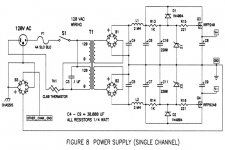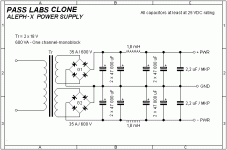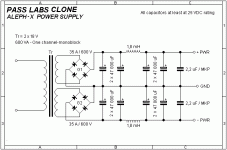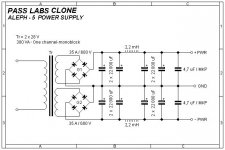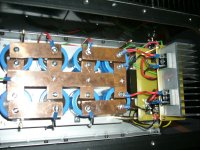hi all
what sort of output can i get out of the aleph j into 4 ohms if i crank up the bias and add extra sinks ?
is 50w at 4ohm possible ? i can also add extra out put devices if needed but would prefer to run the standard 4 per channel
cheers
what sort of output can i get out of the aleph j into 4 ohms if i crank up the bias and add extra sinks ?
is 50w at 4ohm possible ? i can also add extra out put devices if needed but would prefer to run the standard 4 per channel
cheers
See the spreadsheet here: http://www.diyaudio.com/forums/pass...-x-calculationsheet-axe-1-2-a.html#post552824
You can do 50W/4R with 4 output devices and HUGE heat sinks, probably fan cooled. or just push the junction temperature into the shorter life region.
You can do 50W/4R with 4 output devices and HUGE heat sinks, probably fan cooled. or just push the junction temperature into the shorter life region.
hi bob
is that with a standard aleph j with higher bias and bigger sinks ? ie not ajx
thanks in advance regards sheafer
is that with a standard aleph j with higher bias and bigger sinks ? ie not ajx
thanks in advance regards sheafer
You could do it by changing the current gain but it would no longer be a J. There is no replacement for displacement (dissipation).
displacement as in extra output devices?
like 3x pair per channel instead of 2 pair as standard
could the 2sj109 run the extra pair per channel and support the extra current needed to bias them high enough for the 50-60w in to 4 ohm safely
regards sheafer
like 3x pair per channel instead of 2 pair as standard
could the 2sj109 run the extra pair per channel and support the extra current needed to bias them high enough for the 50-60w in to 4 ohm safely
regards sheafer
If you add another pair to the output you will also change the current gain somewhat because the ratio will change, but it makes a large bias increase a little easier to deal with. Still, getting 40W out means lots of heat. Just the standard bias using 6 OPTs is around 170W of dissipation per/ch. I'm building one with 6 OPTs and I have paralleled 2sj74s in the front end to eliminate any question of drive.
Another option would be to lower the rail voltage, thereby lowering the dissipation and allowing more bias capability and optimizing it more towards a 4 ohm load.
Whatever you do it will not be a true Aleph J unless you balance the current gain back to 25%.
I'm sure others have their opinions on this.
Another option would be to lower the rail voltage, thereby lowering the dissipation and allowing more bias capability and optimizing it more towards a 4 ohm load.
Whatever you do it will not be a true Aleph J unless you balance the current gain back to 25%.
I'm sure others have their opinions on this.
Hi Bob
Thanks for the calculations... will use the 300mm high sink. I have a 500VA, 2 x 18v secondaries...is this transformer good enough for the PSU? Which PSU scheme is better ? What I have in mind for a 12 mosfet per channel is no longer a Aleph J? Do I need to readjust the bias?
Thanks for the calculations... will use the 300mm high sink. I have a 500VA, 2 x 18v secondaries...is this transformer good enough for the PSU? Which PSU scheme is better ? What I have in mind for a 12 mosfet per channel is no longer a Aleph J? Do I need to readjust the bias?
Attachments
... There is no replacement for displacement (dissipation).
That's a muscle car reference.
is that with a standard aleph j with higher bias and bigger sinks ? ie not ajx
I assumed you meant to ask about AJ-X given the title of this thread. Just 8 outputs (same load on input as a AJ) is a bit dicey thermally. Plug it in to the spreadsheet. The spreadsheet will work for the AJ thermals, but the power output calculations don't work.
Bill's suggestion of doubling up the input devices is a good way to ensure that you have enough drive to handle the 12 pairs of outputs that would make the thermals work reasonably.
AFAIK, the AC current gain is set by the ratio of two resistors, not the number of output devices. I don't have the schematics handy to identify them, but they are connected to the base of the bipolar in the current source. Therefore, adding outputs won't alter the current gain.
Hi Bob
Thanks for the calculations... will use the 300mm high sink. I have a 500VA, 2 x 18v secondaries...is this transformer good enough for the PSU? Which PSU scheme is better ? What I have in mind for a 12 mosfet per channel is no longer a Aleph J? Do I need to readjust the bias?
If you want to be a strict about it, any change from the original schematic makes it something other than an AJ-X. Different current gains mean different sound character. However, in my mind, it is still an AJ-X whether the current gain is set to 20% or 60%.
The AJ-X isn't as easily scaled as the A-X (if you want to call it easy to scale), due to lower drive current capability of the jfets. Doubling up seems like a reasonable solution, but I have not built the amp.
I'd go for the unregulated CLC - you're generating enough heat already and this amp has reasonable PSU ripple rejection. If you are shooting for 100W per channel output, that transformer is good for a single channel.
That's a muscle car reference.
I assumed you meant to ask about AJ-X given the title of this thread. Just 8 outputs (same load on input as a AJ) is a bit dicey thermally. Plug it in to the spreadsheet. The spreadsheet will work for the AJ thermals, but the power output calculations don't work.
Bill's suggestion of doubling up the input devices is a good way to ensure that you have enough drive to handle the 12 pairs of outputs that would make the thermals work reasonably.
AFAIK, the AC current gain is set by the ratio of two resistors, not the number of output devices. I don't have the schematics handy to identify them, but they are connected to the base of the bipolar in the current source. Therefore, adding outputs won't alter the current gain.
The current gain is also affected by the current through the sensing resistors at the output so they are interrelated.
True. In many builds the number of sense resistors goes up in conjunction with the number of output devices, keeping the net sense resistor to net ACS source resistance ratio the same 2:1. Makes for easier scaling by only changing one factor.
I was merely trying to point out that the 25% current gain of the Aleph J is a design point that NP has aimed at , it is mentioned in the description of the Aleph J on the FirstWatt website.
Hi
Thank you very nuch, bob and bill, i appreciate both your advice.
I still think it is an Aleph J...characteristic wise....just the watts is higher...
errr...the clc is the one below? I have build the aleph 5 using the the PSU similar to this and IMHO, it is good....just that it the cost is high
the other disadvantage is the rectifier.....it really runs VERY hot.....must look for a really good oneView attachment 175710
Thank you very nuch, bob and bill, i appreciate both your advice.
I still think it is an Aleph J...characteristic wise....just the watts is higher...
errr...the clc is the one below? I have build the aleph 5 using the the PSU similar to this and IMHO, it is good....just that it the cost is high
the other disadvantage is the rectifier.....it really runs VERY hot.....must look for a really good oneView attachment 175710
Attachments
Last edited:
What are you using for a bridge? What was the load that got it too hot? Did you measure the temperature?
If that's a standard glass passivated bridge, you should drop around 1.1V, which is only 11W @ 5A (positive and negative sides each conducting simultaneously). Too much not to heat sink, but you should be able to simply mount it to a 3mm or thicker case bottom.
A typical 35A bridge has an R(jc) of 1.5C/W. At 11W the case could be 125C and the junction still would be safe.
In other words, you don't need a whole heat sink section for your bridges unless you are really going crazy with the bias, or want to use a single bridge for two channels.
Yes, that's the CLC one - the other is CLC plus a regulator Capacitance-L(inductance)-Capaticance
If that's a standard glass passivated bridge, you should drop around 1.1V, which is only 11W @ 5A (positive and negative sides each conducting simultaneously). Too much not to heat sink, but you should be able to simply mount it to a 3mm or thicker case bottom.
A typical 35A bridge has an R(jc) of 1.5C/W. At 11W the case could be 125C and the junction still would be safe.
In other words, you don't need a whole heat sink section for your bridges unless you are really going crazy with the bias, or want to use a single bridge for two channels.
Yes, that's the CLC one - the other is CLC plus a regulator Capacitance-L(inductance)-Capaticance
Hi Bob
The attached PSU schematic is the one I used for my aleph 5 and the rectifiers are fixed to a sink (size = 5.5" x 2.5" x 2.5"). No, I did not measure the temperature, pretty sure it was too hot for the sink. I am listening to these amps now but is thinking of dismantling it for the capacitors.
I wonder if these capacitors are suitable for the Aleph j-x PSU, in place of the 47000uF capacitors specified.
The attached PSU schematic is the one I used for my aleph 5 and the rectifiers are fixed to a sink (size = 5.5" x 2.5" x 2.5"). No, I did not measure the temperature, pretty sure it was too hot for the sink. I am listening to these amps now but is thinking of dismantling it for the capacitors.
I wonder if these capacitors are suitable for the Aleph j-x PSU, in place of the 47000uF capacitors specified.
Attachments
Looks like that should be plenty of heat sink for the rectifiers. Did you use thermal grease? Rectifiers are big and easy to touch the metal parts. If you could touch the mounting surface of your output devices you'd probably see they were to hot to touch, too.
PSU cap values aren't critical, but more is better, within reason.
PSU cap values aren't critical, but more is better, within reason.
Sloan rule : 1000uF per reservoir for every 10 watts, 100 watts = 10,000uF per reservoir....plus another 10% = 11,000uF. I think 22000uF per capacitor should be good enough. Needs confirmation.
Looks like that should be plenty of heat sink for the rectifiers. Did you use thermal grease?
No, I did not use any thermal grease...thought it was not necessary?
That's a class AB rule. Class A draws a lot more current and therefore needs more capacitance to keep ripple at bay.
The grease helps fill in the gaps in the surfaces and improve thermal conductivity. Without it you will see hotter rectifiers. That's a relatively quick fix.
The grease helps fill in the gaps in the surfaces and improve thermal conductivity. Without it you will see hotter rectifiers. That's a relatively quick fix.
Class A draws a lot more current and therefore needs more capacitance to keep ripple at bay.
 Okay. Should I use the 22000uF? Will there be a big difference between 22000uF and 47000uF? These bigger caps are expensive and I would like to reuse the 22000uF to save on cost.
Okay. Should I use the 22000uF? Will there be a big difference between 22000uF and 47000uF? These bigger caps are expensive and I would like to reuse the 22000uF to save on cost.- Home
- Amplifiers
- Pass Labs
- Aleph J-X Amp Project
